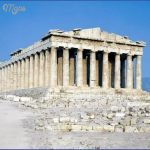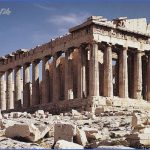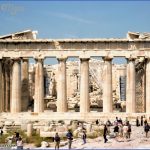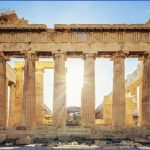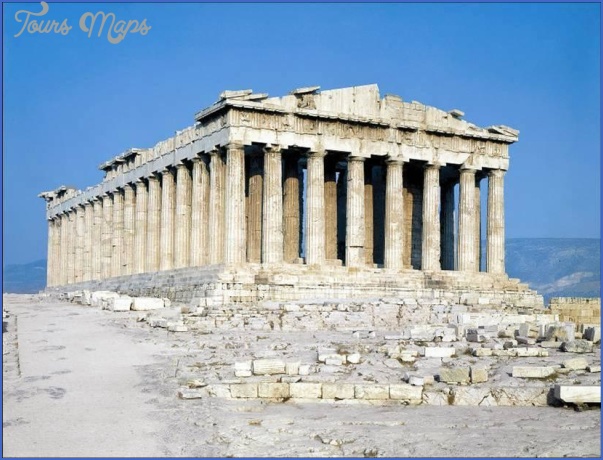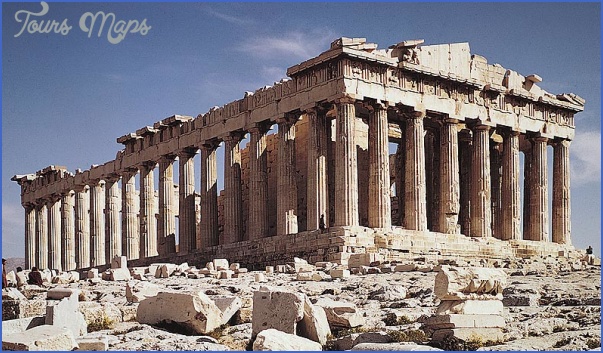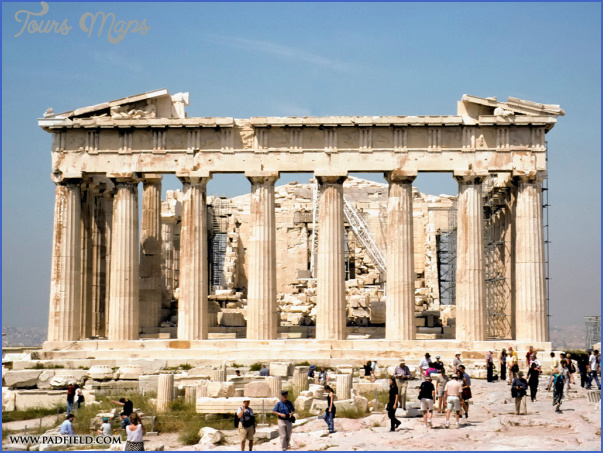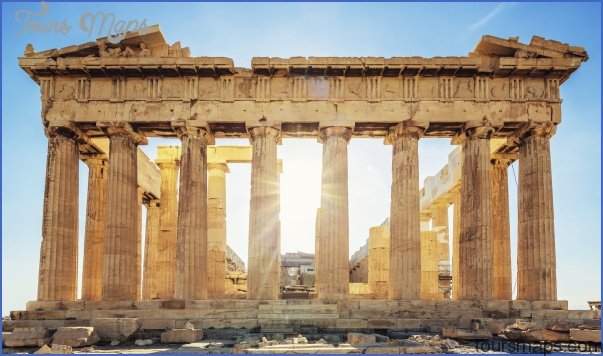KALLIKRATES AND IKTINOS
By the middle of the 5th century bce Athens was the most powerful city in Greece and one of the major cultural centers of the ancient world. In 447 bce, the Athenians began to rebuild the temples on the Acropolis (the hill overlooking Athens), which had been badly damaged during wars with Persia. The largest new structure was the Parthenon, a temple to Athena, the city’s patron goddess. At the heart of the building, in the shrine known as the cella, was a huge statue of the goddess made of ivory and gold.
Prized for its proportions and outstanding set of decorative carvings, the Parthenon quickly became the most famous Greek temple, and its architecture was widely admired and imitated. Architects Kallikrates and Iktinos modified Doric, the simplest of the Greek orders (see p.23), by introducing a sculptural frieze around the building, an unusual feature in a
Doric structure. They also employed optical tricks to make the building appear perfectly proportioned. The platform on which the temple stands is convex, and the columns lean slightly-both effects that are said to trick the eye into seeing the building as perfectly straight.
The Parthenon was not always used as a temple. In 1687, the Turks, who ruled Greece, used it to store arms and explosives during their war with Venice. The Venetians attacked the temple and blew it up, making off with some of the sculptures from the building. In the early 19th century British ambassador Lord Elgin acquired many others. These carvings remain in the British Museum, but the Greeks have built a new museum for them and hope to rehouse the sculptures there one day. Even in its ruined state the Parthenon is one of the world’s most remarkable buildings.
ON SITE
The Acropolis had been a major religious site for about 1,000 years before the Parthenon was built. Other than the Parthenon, which dominates the site, the Greeks built three other major buildings in the 5th century BCE two temples, the Erechtheum and the temple of Athena Nike, and the Propylaea, a great ceremonial gateway. These buildings occupied a site that was central to Greek history and myth some of the older structures, wrecked by the Persians, were left untouched, and the Erechtheum was built on the very spot where, according to legend, Athena and Poseidon fought over who should be the patron deity of Athens.
The Acropolis, dominated by the Parthenon
WEST METOPE The metopes on the temple’s west end depict a legendary battle between the Athenians and the Amazons, a mythical race of warrior women. This subject was especially important on a temple dedicated to Athena because the scene was also shown on the shield carried by the goddess. The defeat of the Amazons is another example of Greek triumph.
SOUTHERN FRIEZE The temple’s friezes are made up of trigylphs (simple patterns of three vertical bands) alternating with sculptures in low relief known as metopes. Although many of the metopes have been removed, a few remain, including the one above. This is part of a series depicting a battle between a Greek people called the Lapiths and the centaurs, mythical beasts that were part-human, part-horse. Carvings such as these were meant to show the triumph of Greek civilization over barbarism. They were the work of the great Athenian sculptor Phidias, or of those working under him.
DORIC ORDER The Parthenon’s outer columns are Doric, the order that tops fluted columns with an unadorned square slab called an abacus. The simple shapes of the architecture catch the sun beautifully, making the design clear in the strong Mediterranean light. Above the abacus are the horizontal bands of stone that make up the entablature: first the plain band called the architrave, then the more ornate band known as the frieze.
Frieze
Pediment with sculptures of the birth of Athena, witnessed by the gods (no longer present)
ON CONSTRUCTION
The ancient Greeks developed a series of style variations called the orders, which they used to design columns, together with the structures supported by them, on their temples, monuments, and other buildings. There were three orders, and each provided a series of guidelines for these architectural elements.
The orders were highly influential and were adopted and extended by the Romans and later civilizations.
The simplest and earliest of the orders is the Doric, which has fluted columns topped very plainly with two stones the tapering echinus and square abacus. The Ionic order is slightly more ornate, and its capitals are adorned with spiral volutes. The last and most decorative of the three orders is the Corinthian, which has capitals featuring the curling leaves of the acanthus plant. Both the Ionic and Corinthian orders have a base, a wider section between the column and the ground, while the Doric usually lacks a base.
Ionic
COLONNADE The columns at the corners are spaced slightly more closely together than the rest of those in the Parthenon colonnade. This slight irregularity in the design gives the temple fagades more variety and rhythm than they would otherwise have.
Stylobate (platform on which the temple stands)
FRIEZE This inner frieze shows a procession of Athenians carrying gifts for the goddess Athena. This event probably represents part of the Great Panathenaic Festival, which was held in Athens every four years and involved religious sacrifices, games, and cultural events. Some of the participants in the procession have brought a special robe made by the women of Athens, to place on the statue of the goddess in the temple.
Reconstruction of the Parthenon, showing the position of the cella, cult statue, and sculptures that are no longer present.
TEMPLE INTERIOR Within the Parthenon’s outer ring of columns, the walled interior was divided into two separate spaces. The larger of these, at the eastern end of the building, is about 98ft (30m) in length. It contained the enormous cult statue of Athena itself some 42ft (12.8m) high made by Phidias. The room was surrounded by a further series of columns on three sides, but apart from its end wall and tall doorway, most of the interior has been destroyed.
THE PARTHENON GREECE Photo Gallery
Maybe You Like Them Too
- The Best Cities To Visit in The World
- World’s 10 Best Places To Visit
- Coolest Countries in the World to Visit
- Travel to Santorini, Greece
- Map of Barbados – Holiday in Barbados

